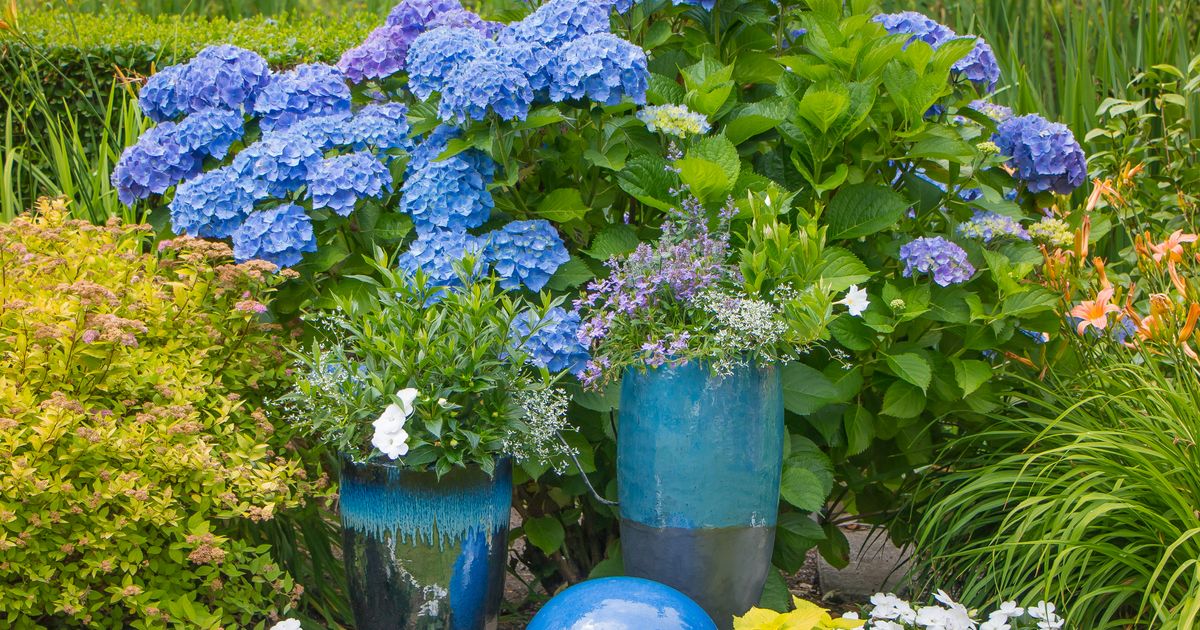If your garden could use a little pizazz, it may just need some accessorizing. Just like a well-chosen scarf or bracelet can springboard an outfit from meh to marvelous, an eye-catching container can do the same for your patio view. Here, local experts share their top container design strategies to make any garden sparkle.
“I love putting containers in the garden,” says Susan Papanikolas, of How Does your Garden Grow in Seattle who has been garden coaching for more than 20 years. “They take a nice garden and elevate it in a really nice way. They provide a focal point that is hard to achieve with plants alone.”
Papanikolas says they add focus to planted spaces and bring a welcome dose of color and life to hardscaped areas like roof decks, entries, driveways and patios.
Striking planters can be used to highlight a doorway or threshold, mark a pathway or special view, or mask an unsightly one.
“Containers get overlooked at having the ability to bring so much personality to a setting,” says Renton-based designer Christina Salwitz, who goes by The Personal Garden Coach.
Foolproof color recipes
Salwitz is an administrator for “Container Gardening Northwest” on Facebook with over 4,000 members. She revels in exuberant combinations and is happy to see colorful pots on the rise after a trend toward drab neutrals. Teal and violet are her neutrals.
She installed one dubbed lovingly “the hippy, dippy, trippy pot” in waves of purple, orange and copper. As a focal point container at a traditional house, Salwitz says, “It’s an absolute showstopper.”
When crafting planting combinations, she says, “I have some color combos I’ve learned that are universally workable, and I can make those work for any exposure just by switching out plants.” Some examples are a citrusy blend of red, orange and yellow, or a high-contrast duo of white with red or blue. But her favorite skews more tropical.
“There is one that is super-popular and works every time,” Salwitz says. “It’s orange, chartreuse, violet and fuchsia. We can take that from full hot sun to full shade. I’ve done it in Oxblood red or gray pots. It goes with everything.”
Color echoes, or repeating colors in plants and containers, help unify a plant combination or a collection of pots and marry them to their surroundings.
“My favorite multiuse strategy, whether for one or a cluster of pots, is to have something small and flowering I use throughout, like million bells (Calibrachoa spp.),” Papanikolas says. “I’ll pick one color to give unity to one pot or a cluster. If I’m doing a deck, I’ll do multiples of one color to have one corner speak to another.”
If you take time to reward the eye with color echoes, like matching a million bells with the stem of a hebe, she says, the combination will sing.
Beyond thriller, filler and spiller
A common suggestion for pot structure is to have a thriller (tall accent), filler (mounded plant) and spiller (trailing plant). Salwitz goes macro, looking for three heights, three colors and three textures, contrasting airy and bold leaf shapes and round and spiky plant forms.
High performers
In picking out your plants, first choose plants that suit the sun exposure, the drainage of the pot and your maintenance needs.
Consider your watering plan; containers dry out faster than in-ground plants and may need watering daily during heat spells. Will you water by hand or irrigation? Drip irrigation systems can be helpful for vacations.
Are you interested in changing out the plants seasonally for the freshest color, or would you prefer a longer-term planter? Most trees and shrubs will need root-pruning or replacement, and refreshed soil after two or three years depending on how fast the plants grow.
Papanikolas likes to choose a year-round “anchor plant,” like an evergreen or red twig dogwood (Cornus sericea) that stays year-round and add changing seasonal “characters” for colorful blooms.
Salwitz’s tip for long-lasting pots is to choose a small tree or shrub that can be planted in the garden in a year or two. The customer gets a smaller, less expensive plant that does double duty in the landscape. Distinctive foliage or structure delivers the best bang for your buck.
Some of Papanikolas’ favorites in shade are Drimys lanceolata, a shrub, and perennial hellebores and heuchera. Her standouts for sun are Euonymous (Green Spire), compact Phormium (Tom Thumb) and dwarf conifers like Thuja plicata (Whipcord) and Chamaecyparis pisifera (Baby Blue).
Salwitz calls out “fancy-leaf” versions of begonias for shade and geraniums for sun (which can be overwintered inside), coleus, oxalis and perennial Japanese Forest Grass (Hakonechloa spp.).
For annuals, Salwitz says it’s worth springing for newer, more expensive varieties that bloom longer and don’t need deadheading. She loves (Techno Heat) lobelia (Lobelia erinus ‘Techno Heat’), the Wishes salvia series, zinnia (Profusion) series, SunPatiens impatiens, and in petunias, look for Wave, Surfinia and Petchoa SuperCal (a petunia-calibrachoa hybrid).
She shops the houseplant and tropical section for an exotic touch, like a hot pink Ti plant (Cordyline fruticosa) or a tiger-striped bromeliad.
Pick your vessel
Often, it’s all about the plants, but sometimes a distinctive container is part of the design. Anything from a tree stump to a coffee mug or statue can be a container — if it matches your plants’ needs. Except for pond plants like waterlilies, plants require one or more drainage holes. (Drainage holes can be drilled but may require a special drill bit for the material.)
High-fired ceramics, while heavy, are the material of choice for long-term use over several winters; look for frost-proof containers. Bigger, sturdier containers will withstand frost better than small, thin-walled pots. The more insulating soil around a plant’s roots, the better.
You’ll want to match your container to your plants. Strawberries and lettuce can grow in shallow rain gutters only 5 inches deep, but shrubs and trees need a lot more root space to grow and insulation to overwinter. Avoid planting bigger plants in pots that curve inward at the top — you’ll probably have to break that pot when it’s time to replant your tree.
Planting tips
One major myth to bust: fill your pots top to bottom with potting soil only.
While people often hope to save money on soil and have lighter pots by filling the base with alternatives from gravel or Styrofoam to plastic water bottles, Salwitz says doing so creates a false water table that can rot roots and is a nightmare to fix when replanting.
“I’ve seen hard hats, vinyl table clothes, you name it,” she says.
Garden soil is too heavy for containers, so purchase a good quality potting soil or potting mix with organic materials like minerals and mycorrhizae, but without wetting agents or herbicides.
Salwitz prefers nutrient-dense, well-draining and peat-free mixes like Kellogg Organics patio plus potting soil and Gardner & Bloome (G&B) organic potting soil, or for a less expensive choice, McClendon Hardware’s Premium Potting Mix.
Both designers use slow-release organic fertilizer at planting. Salwitz says since you can’t overdose on it, she often triples the application recommendations, so she doesn’t need to reapply midseason. An exception would be hanging baskets, which are watered so often they may need an extra does midsummer of liquid fast-acting fertilizer.
Armed with these tips, you’re ready to plant some bling for your garden!
Erica Browne Grivas
is a Seattle-based freelance writer; ebgrivas@gmail.com.




